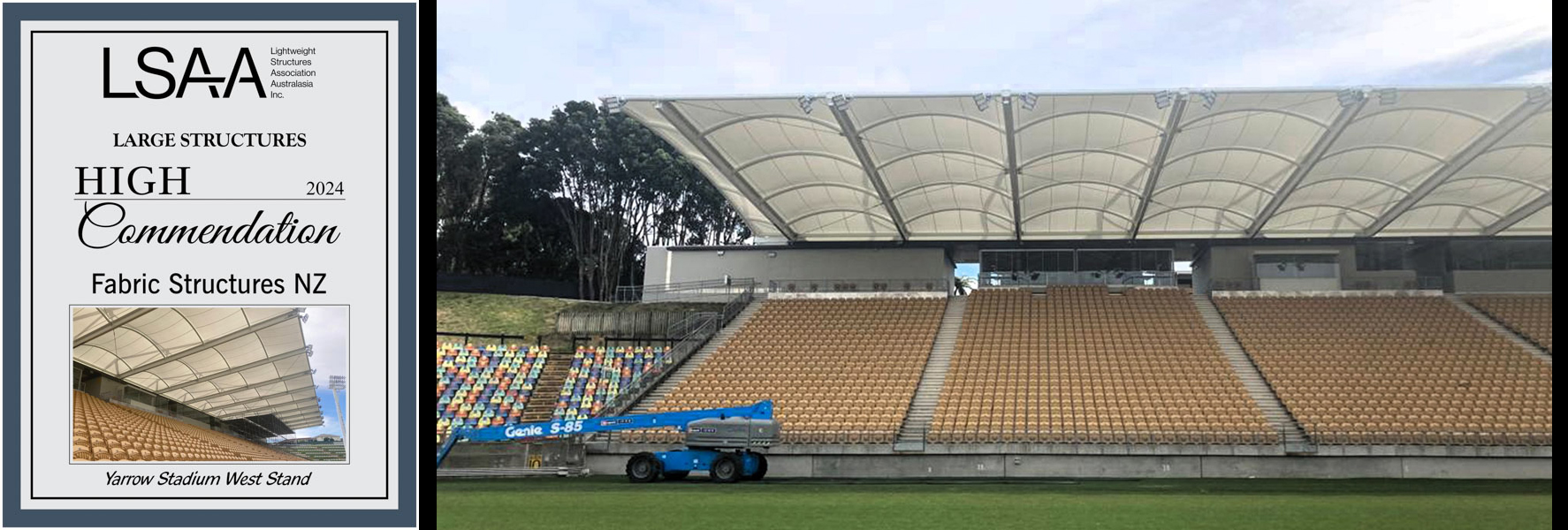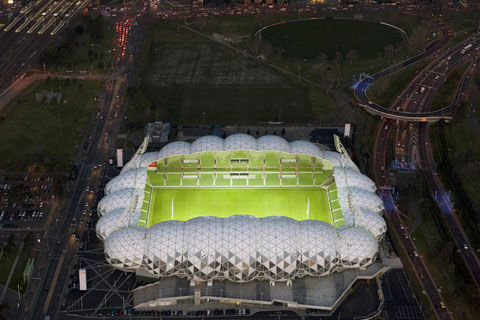APPLICATION OF PROJECT: Stadium Roofing Canopy
PROJECT DESCRIPTION:
Yarrow Stadium in Taranaki was scheduled for a major redevelopment to comply with modern earthquake regulations and ensure the venue remained fit for purpose, aligning with the grow city’s cultural and sporting needs. Following the declaration of the west stand as earthquake-prone in 2018, we were commissioned to design, engineer, and provide a lightweight fabric roof solution that would integrate with the existing structural steel of the west grandstand, also known as the Noel & Melva Yarrow Stand.

DESIGN / FABRICATION / INSTALLATION BRIEF
We were commissioned to design, engineer, and deliver a lightweight fabric roof solution for the west grandstand of Yarrow Stadium, integrating it with the existing strengthened structure. The Taranaki Stadium Trust, in collaboration with Ngāti Te Whiti, had a comprehensive vision for the stadium's refurbishment which emphasised cultural design elements to reinforce the strong ties between the stadium and the hapū.
The project involved adapting to the existing structure, which consisted of 14 rafters and required 13 individual panels, along with two wing panels at the north and south ends of the stand. Our goal was to create a modern, cost-effective roof solution that seamlessly fit the existing steel framework, was lightweight to meet seismic requirements, and enhanced the overall aesthetic of the stadium.
Given the constraint of avoiding any work during the NPC rugby competition, meticulous planning and sequencing of the construction phases were crucial to ensure timely and efficient execution.
STRUCTURAL SYSTEMS
The existing structure consisted of 14 rafters requiring 13 individual panels, plus two wing panels at the north and south ends of the stand. Due to the steel-clad structure not meeting modern seismic requirements, extensive ground stability work and foundation tiebacks were necessary before the existing roof could be removed. New arches and DonoBraces were installed to future-proof the west stand, and all existing steel was repainted prior to the installation of the new fabric roof.
MATERIALS
For this geometric build, we recommended using Serge Ferrari’s TX30-II, a specialty PVC commonly used for stadiums and open-air roofing. The TX30-II is a high-performance membrane that utilizes advanced crosslink technology to enhance its durability, strength, and longevity, and provides excellent resistance to UV rays. It allows significant natural light transmission, creating well-lit environments while still providing necessary shading and protection from the elements, which in turn provides good energy efficiency as it reduces the need for artificial lighting. New Plymouth experiences diverse weather, and the TX30-II is highly resistant to a range of weather conditions, including wind, rain, and temperature fluctuations. It also meets New Zealand’s stringent fire safety standards, making it a safe choice for large public venues. As with all our fabrics, we sourced the TX30-II directly from the manufacturer to ensure quality and consistency.
In summary, we chose TX30-II for its exceptional performance characteristics, its ability to transmit natural light, and its proven track record in similar high-profile applications. Its durability and resistance to environmental factors ensure a long-lasting solution that meets both aesthetic and functional requirements. By selecting Serge Ferrari’s TX30-II, we ensured that the project benefited from cutting-edge materials that provide both practical and aesthetic advantages, aligning with the client's vision and the project's demanding specifications.
FABRICATION
To accommodate the existing steel structure, we designed a bespoke fabric gutter system between each rafter, effectively channeling rainwater from the canopies into the internal gutter at the rear of the stand, ensuring efficient water management and preventing potential structural damage. The fabric panels were cut using CNC (Computer Numerical Control) machines to achieve millimeter-accurate dimensions, crucial for ensuring each panel fit perfectly within the designated spaces between the rafters, maintaining tight tolerances and ensuring the integrity and seamless appearance of the roof.
The panels were then welded using hot air welding, enabling strong, durable, and waterproof seams. Custom leather boots were installed at the interface between the fabric and the existing steel bracing struts, acting as protective covers to prevent abrasion and wear caused by movement and tension. The fabric was meticulously dressed into the internal gutter at the rear of the stand, involving careful folding and securing to ensure a watertight seal and seamless integration with the gutter system.
COLLABORATION, CONSTRUCTION AND MAINTENANCE
Effective collaboration was a cornerstone of the project. We engaged stakeholders through regular meetings with the Taranaki Stadium Trust, project managers RCP and building contractors Clelands Construction, ensuring alignment with the vision and incorporation of cultural design elements. Continuous feedback loops were implemented to promptly address concerns and integrate suggestions.
An integrated design process involved cross-disciplinary teams, including architects, engineers, and cultural consultants, fostering a holistic approach. Digital tools like Building Information Modeling (BIM) facilitated real-time collaboration and coordination among team members.
Supplier coordination was also critical. We worked closely with Serge Ferrari to ensure timely delivery and quality assurance of the TX30-II fabric. Additionally, local coordination with MacWeld (South Auckland) Steel Supply ensured consistency and compatibility with existing structures.
Pre-construction preparations began with thorough site assessments to understand existing conditions and identify potential challenges. Major ground stability works and foundation tiebacks were undertaken by third-parties to meet modern seismic requirements before the removal of the existing roof.
Structural enhancements included the installation of new arches and DonoBraces to future-proof the west stand, ensuring compliance with safety and earthquake standards. All existing steel was repainted to match the new components, ensuring aesthetic consistency and added protection.
The installation of the fabric roof involved the fabrication of 13 separate panels and two wing panels to fit the existing 14 rafters. The installation sequence was meticulously planned to avoid disruptions during the NPC rugby competition, ensuring efficient and timely completion.
The maintenance program includes routine inspections and cleaning. Structural inspections will regularly check the integrity of the steel structure and new arches and DonoBraces, while periodic assessments of the TX30-II fabric will monitor for signs of wear, tear, or UV damage.
Cleaning and care involve yearly surface cleaning to maintain the fabric’s appearance and performance, ensuring it remains free of dirt and debris and in line with the manufacturer’s warrantys. Documentation and reporting are also integral to the maintenance program. Detailed records of all maintenance activities, inspections, and repairs are maintained.
By implementing these collaborative techniques, construction methods, and a robust maintenance program, the new fabric roof for the West Stand at Yarrow Stadium is designed to ensure long-term durability, safety, and aesthetic appeal.
COSTS
We initially presented the client with three budget proposals to highlight the significant variation in steel prices from three different providers. After thorough discussions, the client agreed with our recommendation to proceed with MacWeld (South Auckland) Steel Supply. The budget for this project differed from many others due to the pre-existing core structure.
Steel supply made up 36% of the budget, which included matching the topcoat of the existing steel to the new steel. Engineering and design accounted for 5% of the budget for the above-ground structure.
Fabric supply and installation comprised 52% of the budget for the tensile canopy.
This budget allocation ensured that we could meet the project’s requirements efficiently while maintaining high standards of quality and performance.
COLOUR IMAGES






